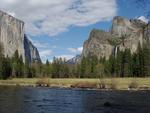Another problem that Mather faced near the start of his parks administration revolved around the city of San Francisco's road and trail responsibilities under the Raker Act, which city and county representatives had in 1913 declared their willingness to perform. After the war Mather began insisting that the city meet its obligation by constructing good concrete roads. He and City Engineer O'Shaughnessy talked considerably of the matter but had not resolved the impasse by the time of Mather's death in 1930.
During the summer of 1925 the board of supervisors of the city and county of San Francisco passed a resolution directing the city Board of Public Works to remove the Hetch Hetchy Railroad tracks and related apparatus between Mather and Damsite and to resurface the roadway to make it available for vehicular t r a f f i c . The park deemed this an important action from an administrative standpoint and also to open up the northern part of the park to tourist travel. Since June 1923, according to park superintendent W.B. Lewis, the railroad had only been used for propoganda purposes, bringing in people who used the city's services to impress them with the importance of the reservoir as a water supply and to build up public opinion against utilizing the Tuolumne watershed for tourist purposes. The Park Service then wanted the city to construct a scenic road around the north side of the reservoir (never constructed) to provide access to the trail system leading up the Grand Canyon of the Tuolumne and into the northern part of the park. The Park Service and the city decided not to allow tourist travel over the steep and narrow roadbed from Hetch Hetchy to Lake Eleanor, which contained dangerous switchbacks.
On 19 September 1925 the new nine-mile auto road between Mather Station and the Hetch Hetchy dam officially opened to the public, an event regarded as heralding a new era of development for the Hetch Hetchy region.
Re: Mather's reign: Hetch Hetchy Area
All posts are those of the individual authors and the owner
of this site does not endorse them. Content should be considered opinion
and not fact until verified independently.
Sorry, only registered users may post in this forum.



